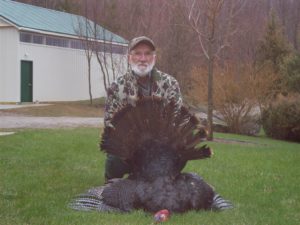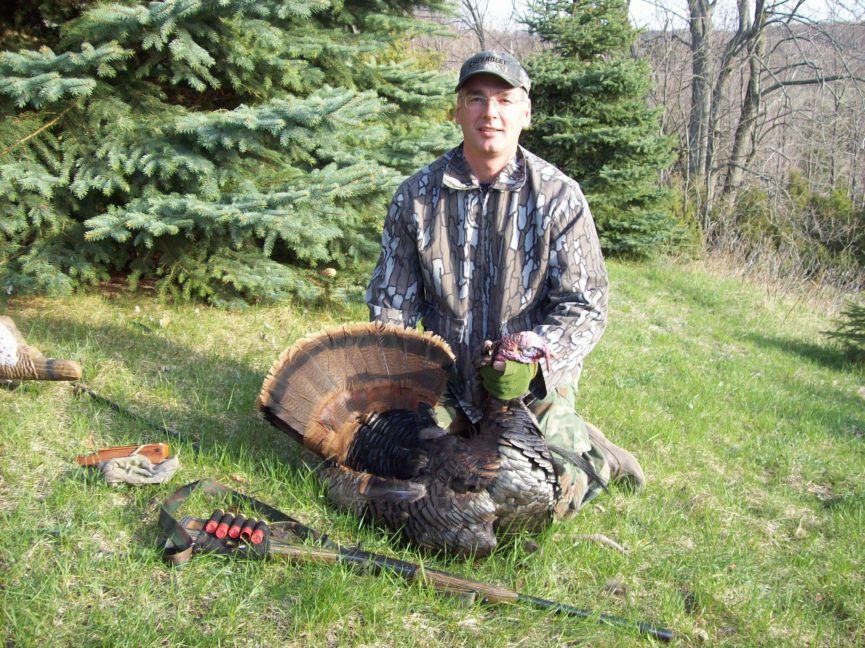
By: Jim Kushner.
During my first few years trying to bag a gobbler, I learned a couple of important things about turkeys and hunting them.
First, you must find out where they are. That means scouting a short time before season opens. I’ve scouted a spot several weeks in advance, only to return later and find the turkeys had moved on or had become call-shy because other hunters had been there ahead of me.
That doesn’t mean you won’t see turkeys there. One year I found a small piece of state land with several toms in the area. When I returned to hunt, I found lots of tire tracks and footprints, and could not locate a bird anywhere. I didn’t go back for a couple days and was almost surprised when I blew my crow call just before daylight. At least two toms were roosting within 100 yards of me!
I set up at the base of a hill on an old two-track that ran along the edge of a swamp. After the gobblers left the roost I never heard them again. Still, I sat for a while and called occasionally.
Finally, I decided it was time to move on and started to get up… A tom took off just above me on the hill and flew out of sight into the swamp.
I don’t know where he came from, but I never heard him and he definitely wasn’t one of the birds I originally heard. Had I been more patient I might have had a shot at that bird. A couple of days later I returned to the same area and was calling to a distant tom that answered my every call. He was on private property, so I set up my decoys and sat down to see if he might come to me. We probably called to each other for about 30 minutes and he wasn’t getting any closer. Just when I figured it was a lost cause I heard a noise behind me. It turned out to be a big tom that was strutting in the two-track about 50 minutes behind me (I later found his tracks and strut marks in the sand). I never would have known that bird was there if he hadn’t walked off the road and crunched the dry leaves as he came up behind me. I couldn’t get my gun turned around without being seen, and he eventually walked out of range.
I didn’t get a shot at that bird, but it really made me wonder how many toms will check out hen calls without making a sound.
If you know birds are around and they have been hunted and spooked, it probably pays to spend extra time to let a silent old tom come and check you out.
On another morning I was walking and calling, trying to locate a bird when I heard a hen clucking on the next ridge. I sat down and we called back and forth for several minutes. I hoped that maybe a gobbler was with the hen, but she just kept walking back and forth on the opposite ridge talking back to me. I sat and tried to imitate her calls when suddenly heard several gobblers from behind me. I foolishly tried to get turned around, but those two toms topped the hill behind me just as I was sitting down. I got a good look at the lead gobbler’s head as he ran down the side of the hill and out of sight.
I wanted to kick myself for moving when I did, but if I had not stayed and called to that lone hen I doubt I would have ever known they were in the area. It sure didn’t hurt to have a live hen calling with me.
I hunted for several years before I finally shot my first gobbler. If you pay attention to what goes wrong when a birds spooks you might be able to avoid those mistakes in the future. If you are persistent, sooner or later everything will come together and that big tom will walk into range of your shotgun.
My first gobbler had an eight-inch beard and weighed almost 25 pounds. He never answered my calls until after I had five jakes gobbling around me for almost 15 minutes. Those jakes stayed around as long as I called. When they walked away I would call them back.
After several minutes I heard another bird gobbling. He eventually joined with the jakes just out of range. As soon as I called again one of the jakes gobbled and started to come back towards me. The big tom didn’t like that and chased the jake away. Then he walked toward me and I dropped him at 25 yards with a load of #6’s.
- My 50th Year Anniversary! - December 7, 2023
- A Methodical Deer Tracking Effort Can Minimize Mistakes - December 21, 2022
- 2019 Challenges Have Turned Into Measures Of Success…the rest of the story! - December 8, 2019

